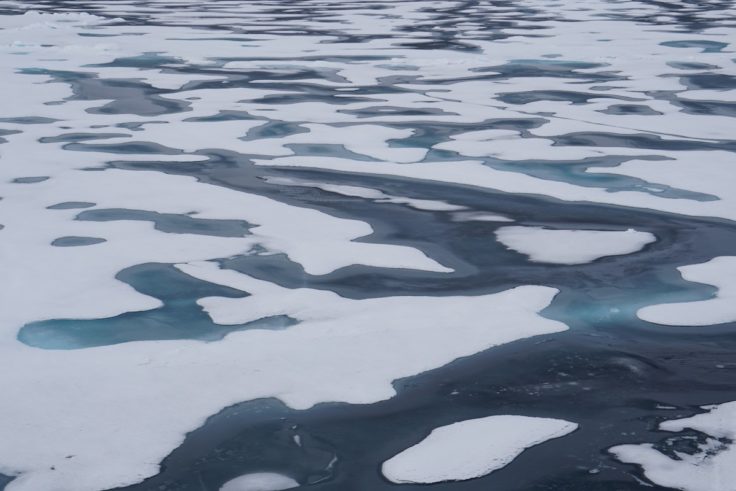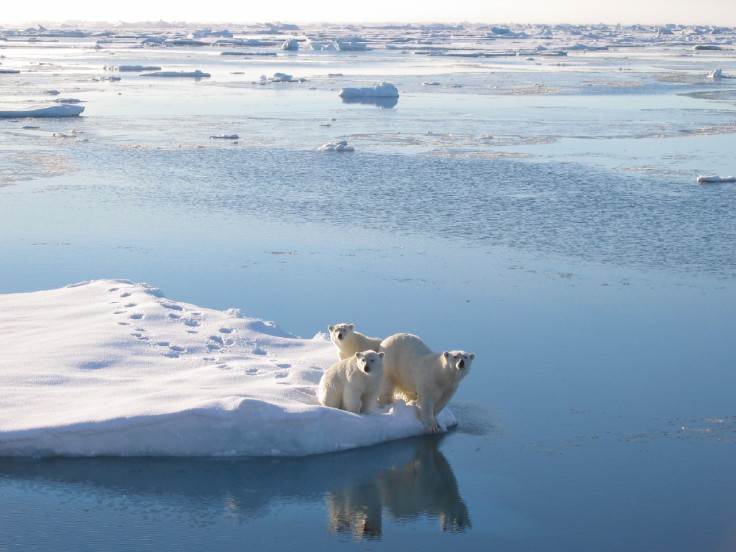The Arctic heatwave of 2020
18 September, 2020
As the Arctic sea ice minimum approaches this month, we share a blog from Professor Mike Meredith at British Antarctic Survey about how the region is rapidly changing in our warming world.
Professor Meredith is Head of the Polar Oceans Team at BAS and led the Polar Oceans chapter of the Intergovernmental Panel on Climate Change special report on the Ocean and Cryospere in a Changing Climate published in September 2019.
How unusual have the conditions been in the Arctic this year, particularly in terms of the heatwave?
The conditions we’ve seen in the Arctic this year have been truly remarkable, and not in a good way. 2020 looks well set to be the hottest on record, and with temperatures reaching 38C in Siberia (Siberia!) what we are seeing is simply staggering. Arctic sea ice extent has also collapsed to some of the lowest levels since satellite monitoring began, with record lows in July and the Northeast Passage now being open in this month for the first time. To put this in context, about a million square kilometres of sea ice have disappeared compared with the last seven years. It is easy to throw around hyperbole, of course – but this is genuinely unlike anything we’ve seen before.

Why is this year so striking?
Like any region on Earth, the Arctic shows pronounced year-to-year changes all the time, driven by internal variability in the planetary climate system – so some years will naturally be warmer than others. However, temperatures observed in the Arctic this year are remarkable even given this, and it’s been shown that a heatwave of the magnitude observed would not have been possible without the effect of humanity’s activities, through greenhouse gas emissions and anthropogenic warming. Of course, the Arctic has been warming strongly for quite some time now – IPCC and other organisations have observed before that it has warmed at twice the rate of the planet as a whole over the past several decades – but to see an individual extreme year of the sort we have, and so soon, is very concerning. It’s as though some of our worst predictions for the future are being played out in front of our eyes, now.
How striking are the region’s wildfires and the low sea ice extent we are seeing this year?
Yes, sea ice records are tumbling this year. We have to wait until the end of the season to see the true quantified impact, but monthly records are certainly falling in places, and this is especially so in the regions within the Arctic most affected by the warming, such as the Laptev Sea. How long these records will stand, only time will tell, but things in the Arctic are moving in one direction, and a very unpleasant one.
What are the impacts we are seeing, in terms of thawing permafrost, CO2 emissions, air pollution?
In addition to the massive reduction in sea ice, there are many other severe impacts of the 2020 heatwave. Wildfires in 2019 were very bad, and 2020 looks set to be equally so. Indeed, some of the 2020 fires are thought to be “zombie fires”, essentially fires that started in 2019 and smouldered over winter, before re-igniting fully during the 2020 heatwave. Millions of acres of native vegetation in Siberia have been lost, with millions of tons of carbon released to the atmosphere. In June alone, Arctic wildfires triggered the release of 56 million tons of carbon dioxide to the atmosphere, more than the yearly CO2 emissions of Norway. Thawing of permafrost is a particular concern – in total, it contains more than twice the amount of carbon as does the atmosphere – so the potential for triggering runaway warming is strong. If that happens, heatwave years like 2020 will become much more frequent, and some years could be much worse.

We know the Arctic is warming and changing faster than the rest of the world, but does it seem to you that 2020 is likely to be an inflection point? Or is it just an aberation?
It’s not necessarily an inflection point, but I think 2020 is a clear window into what is to come. Of course, not all of the Arctic changes are irreversible – for example, sea ice would re-grow if the climate cooled enough – so it isn’t the case that we should fall into despair and inaction. But cooling the climate, or even limiting its warming, is something that we haven’t managed at all well so far – and the time for action is rapidly diminishing. What is urgently needed is effective and widespread coordinated action to slash greenhouse gas emissions, in order to limit the negative impacts of climate change as much as possible, and to prepare for the impacts that are unavoidable. If we don’t, what we’re seeing in the Arctic now will just be the beginning.
Can we expect climate feedback loops to speed up, e.g. because of the change in albedo as sea ice loss accelerates and soot from fires lands on white surfaces?
Unfortunately this is exactly what we should expect. The Arctic is a region of known sensitivity to climate change, but it also contains several feedback loops that can accelerate the global climatic warming that we are currently seeing. These include the loss of sea ice and snow (and hence the protective white coating that they provide, which reflects heat back toward space), and release of carbon to the atmosphere from permafrost thaw. Such feedbacks have the potential to drive global warming rapidly to even more dangerous levels, so we mess with them at our peril – but unfortunately that is exactly what we are doing.
How are people living in the Arctic being affected by environmental change?
One thing to note about the Arctic is that, whilst it matters on a global scale to the climate of the rest of the planet, it is also a region that many people call home. Local and Indigenous populations in the Arctic are already threatened by climate change and warming, which is impacting on them in various ways – destabilising their infrastructure, affecting their hunting and fishing grounds, impacting their cultures and their ways of life. They have a level of resilience and adaptability, but such things are not infinite – there are levels of climate change that they simply would not be able to cope with and preserve anything like the lives they currently lead. The sooner we reach those levels, the less chance there will be for people in the Arctic to adapt and prepare themselves for what is to come. We must think about the threat to these societies and cultures that the current Arctic changes pose, and work to help them minimise the damage being caused.
*This dialogue was between Professor Meredith and Adam Vaughan at New Scientist Magazine for an article published in August 2020.